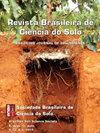有机农业区沙质土壤生物源性和物理源性团聚体的质量指标
IF 2
4区 农林科学
Q3 SOIL SCIENCE
引用次数: 1
摘要
沙质质地土壤在世界范围内的农业地区普遍存在。在Baixada Fluminense,土壤表面的沙质质地非常引人注目,这些地区的很大一部分注定要用传统的种植方法生产蔬菜。沙质结构是农业面临的巨大挑战之一,因为提供给土壤的低保水能力,有机物的快速分解,以及淋滤造成的大量养分损失。在这些地区,有时可以观察到侵蚀过程的作用,无论是水蚀还是风蚀。在传统农业中进行的实践可以强调这些过程。本研究旨在评价不同植被覆盖下不同土壤管理制度对团聚体形成途径、团聚体中养分含量和有机质组分的影响,并将这些特性作为土壤质量的指标。以某有机生产单元为研究对象,采用免耕系统(NT)和常规系统(CT),对3种植被覆盖度进行评价;混合种子1 (C1) (Crotalaria (Crotalaria juncea) (20 kg ha -1), Jack Bean (Canavalia ensiformis) (150 kg ha -1)和谷子(Pennisetum glaucum) (60 kg ha -1)),混合种子2 (C2) (C1中使用的种子量的50%)和自发植物(S. P)。在0.00-0.05和0.05-0.10 m层收集未受干扰的样本,从这些样本中,粒径在9.7 ~ 8.0 mm之间的团聚体按形成途径分为生物成因和物理成因。由此,定量了化学性质(pH, ca2 +, mg2 +, al3 +, P, Na +, K +)和碳组分(总有机碳- TOC,矿物伴生有机碳- MAOC),颗粒有机碳- POC和游离轻组分碳- LFC)。在此基础上,验证了在0.00m ~ 0.05 m层生物源性团聚体百分比高于物理源性团聚体百分比,未验证植被覆盖度和管理制度的影响。化学性质在不同的训练途径之间没有显著差异。在大多数情况下,CT是化学性能值最高的体系,总的来说,C2和S.P涂层是化学性能和碳含量改善最大的涂层。本文章由计算机程序翻译,如有差异,请以英文原文为准。
Biogenic and physicogenic aggregates as indicators of quality in soils with sandy texture in areas of organic agriculture
Sandy texture soils have a great expression in agricultural areas worldwide. In the Baixada Fluminense, soils with a sandy texture on the surface horizons are striking, and a good part of these areas is destined for producing vegetables using conventional cultivation methods. The sandy texture is one of the great challenges for agriculture due to the low water retention capacity provided to the soil, the rapid decomposition of organic matter, and the intense loss of nutrients by leaching. In these areas, the action of erosive processes is sometimes observed, whether water or wind erosion. The practices carried out in conventional agriculture can accentuate these processes. This study aimed to evaluate the influence of different soil management systems, with different vegetation covers, on the pathways of aggregate formation, the nutrient contents contained therein, and the organic matter fractions, with the objective of using these properties as indicators of soil quality. The study was carried out in an organic production unit, with no-till system (NT) and conventional system (CT), three vegetal covers were evaluated, namely; seed cocktail 1 (C1) (Crotalaria (Crotalaria juncea) (20 kg ha -1 ), Jack Bean (Canavalia ensiformis) (150 kg ha -1 ) and millet (Pennisetum glaucum) (60 kg ha -1 )), and seed cocktail 2 (C2) (with 50 % of the amount of seeds used in C1), and spontaneous plants (S. P). Undisturbed samples were collected at the layers of 0.00-0.05 and 0.05-0.10 m, and, from these samples, aggregates with a diameter between 9.7 and 8.0 mm were classified according to the formation route (Biogenic or Physicogenic). From these, the chemical properties were quantified (pH, Ca 2+ , Mg 2+ , Al 3+ , P, Na + , K + ), and also the carbon fractions (total organic carbon – TOC, mineral-associated organic carbon – MAOC), particulate organic carbon – POC, and free light fraction carbon – LFC). Based on the results, it was verified that the percentage of biogenic aggregates was higher than the physicogenic one in the layer of 0.00-0.05 m, not being verified influences of the vegetal coverage or the management system. Chemical properties did not differ significantly between training pathways. The CT, for the most part, was the system in which the highest values of chemical properties were observed, and in general, the C2 and S.P coatings were the ones that provided the greatest improvements for chemical properties and carbon content.
求助全文
通过发布文献求助,成功后即可免费获取论文全文。
去求助
来源期刊

Revista Brasileira De Ciencia Do Solo
农林科学-土壤科学
CiteScore
3.00
自引率
11.80%
发文量
32
审稿时长
9-24 weeks
期刊介绍:
The Revista Brasileira de Ciência do Solo is a scientific journal published by the Brazilian Society for Soil Science (SBCS), founded in 1947, and is responsible for the propagation of original and inedited technical-scientific work of interest for Soil Science.
Contributions must not have been previously published or submit to other periodicals, with the only exception of articles presented in summarized form at professional meetings. Literature reviews are accepted when solicited by the Editorial Board.
 求助内容:
求助内容: 应助结果提醒方式:
应助结果提醒方式:


